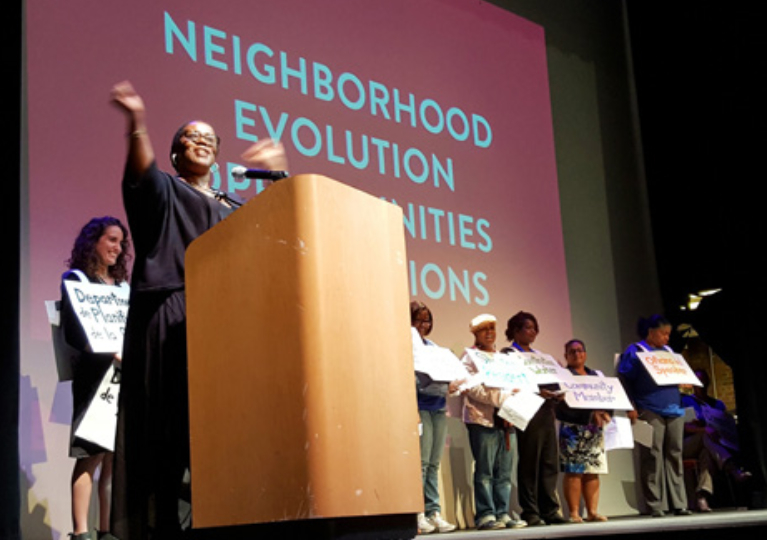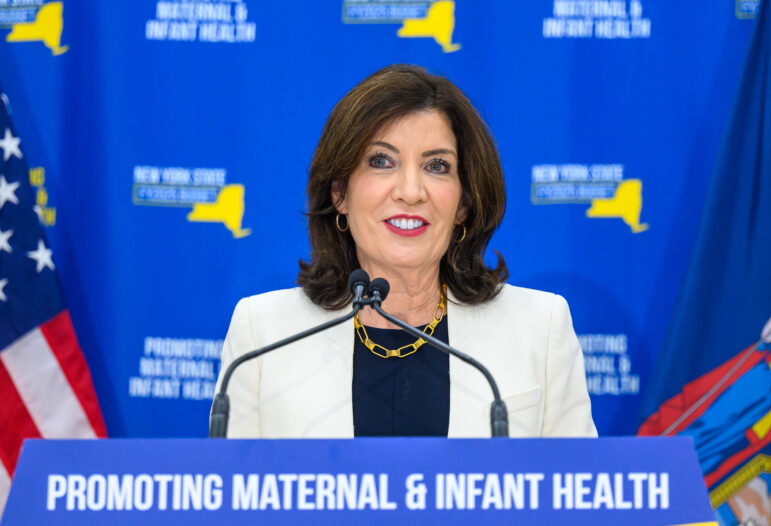
EHNP
A photo from the East Harlem Neighborhood Plan showing one of the community outreach sessions conducted during the plan's preparation. The author believes that process operated quietly and selectively in a community where many residents might prefer no rezoning at all.
Inside a tiny storefront on East 116th street this week, community activists and residents gathered together to prepare for a forum this week on the city’s proposed rezoning plans for East Harlem. The Department of City Planning recently released a draft proposal of what the largely immigrant and Puerto Rican neighborhood could look like in a few years: up to 4,000 new apartments, at least 8,400 new residents, and over 150,000 feet of new commercial space. City planners also estimated that “more than 500 residents” could be directly displaced–which doesn’t include “indirect displacement” that will likely occur further down the line as the neighborhood’s culture and affordability fly out of the window.
East Harlem’s rezoning may be different than the changes coming to other parts of the city because the community is said to have crafted its own plan. Mind you, the plan, known as the “East Harlem Neighborhood Plan” was driven by City Council Speaker Melissa Mark-Viverito (along with other pols and nonprofits), who represents the district. At what level one might accept the plan as a genuine blueprint of what residents want, and not, say, what the city’s 2nd most powerful politician wants, depends on how rose-tinted your view on city politics might be. Marina Ortiz, founder of East Harlem Preservation, a community advocacy group, points to donations made to Viverito (as well as the mayor) by the same developers eyeing the low-income neighborhood. She’s similarly critical of the neighborhood plan, which she notes is supported by groups who receive city funding.
There have been, of course, murmurings over Mayor Bill de Blasio’s intentions with his big “affordable housing” proposals for low-income areas of the city. Some conservative analysts have hailed his plan, crediting the mayor a “deregulator.” Meanwhile, protests sprang up at Gracie Mansion last year by activists who fear gentrification is being escorted in with progressive gloves. Our good mayor has also managed to have more than his share of controversies involving real estate: loosening rules which led to an AIDS hospice turning into luxury condos, having to deny knowing an NYPD-bribing real-estate developer who donated to his campaigns, taking criticism for a scheme to lease NYCHA land to developers.

No Backspace is City Limits' blog featuring a recurring cast of opinion writers passionate about New York people, policies and politics. The views expressed here aren't necessarily those of City Limits. Click here to read more.
Tsk, tsk. These are not the sorts of optics de Blasio and Viverito were probably hoping for.
The “East Harlem Neighborhood Plan”, however, was a smart play by Viverito. By pointing to residents and co-facilitating nonprofit Community Voices Heard, whose membership is made up of low-income New Yorkers (and who’re even protesting de Blasio on that NYCHA land scheme themselves), the speaker has created a buffer between herself and critics of the rezoning. The plan is by the people, for the people! What she won’t admit is that the plan, conceived in less than 10 months, never thought to ask residents if they wanted to be rezoned in the first place. At one of the early planning meetings in February, some were pointing that out:
“There was never an actual debate or dialogue on if we should even be upzoning a working-class community of color,” says East Harlem resident and filmmaker Andrew Padilla. “To call this ‘community driven’ is simply not true. It’s driven by the real-estate industry’s desire to build taller in East Harlem.”
The sheer inevitably of 30-story luxury condos is at the heart of the “neighborhood plan” and has been a central talking point from the de Blasio administration. No, apparently, was never an option.
This is, one could suppose, how city politics works. Let’s not be naive. The fact that the “East Harlem Neighborhood Plan” meetings hosted a few hundred people in a neighborhood with upwards of 125,000 residents means less than a fraction of 1 percent of the neighborhood is necessarily behind said plan. Remarkably, the Speaker calls this a “community-based” initiative “with residents and stakeholders coming together collaboratively to plan for the future of their neighborhood.” A more apt description might be to call it leverage for a politician looking to centralize herself in a lead negotiating role while ignoring critics and the majority of the community who didn’t know about her plan.
Make no mistake, it is the speaker’s plan. I live in El Barrio and never heard of any meetings or “plans” until reading about them after the fact. Ditto for all of my neighbors. The entire process, in fact, reminds me how hurricane rebuilding efforts were handled during the Bloomberg administration when my family lived in Rockaway Park, Queens in 2012. The city hosted a few “charettes” where residents were supposed to craft a “community-led” vision of how the peninsula should be rebuilt to be more “resilient” after Hurricane Sandy. A few dozen residents showed up and we were broken up into multiple tables with pencils and paper like we were in kindergarten. We debated amongst ourselves what we wanted as officials looked on. Eventually, designs conceived in Sweden were chosen in a process sponsored by development firms like L&M Development Partners, Bluestone and Triangle Equities. Our involvement, in reality, was an ornamental gesture.
It was in Rockaway that I met Tom Angotti, an author, Hunter College professor and former city planner himself. He warned us then about the city’s propensity to develop the hell out of neighborhoods with little, if any, safeguards for the community. He was at the meeting in East Harlem earlier this week. The modest stores and bodegas that are the norm for El Barrio, he told a packed room, will be gone if the area is up-zoned “because they can’t afford the high rents.” The building of luxury condos “are not solving the housing problem”, which, Angotti said, could be addressed with existing infrastructure. Real community-led plans, he added, noting Viverito’s plan was put together in months, “takes years… and it should take a long time if you want to deliver.”
Ortiz, Angotti and other residents offer a big fat ‘No’ to the rezoning plans. De Blasio and Viverito, Ortiz says, “need to stop gas-lighting our communities and stop insisting their plan was our idea. They know very well that the NYCHA infill proposals and UP-zoning of poor communities are actually leftover plans from the Bloomberg administration.” She also notes that HPD is primarily federally funded and the city has “no idea what that is going to look like next year – so their promises of affordable housing subsidies are meaningless.”
Alternatively, immigrant-led community organization, Movimiento por Justicia en El Barrio (or Movement for Justice in El Barrio), has outlined its own 10-point plan to protect the neighborhood’s existing housing stock while rejecting the city’s affordable housing plan, which it described as a “luxury housing plan.” Their recommendations, which have been presented to Community Board 11 and made with the participation of the community, they say, have been completely left out of the city’s proposals.This past weekend the groups staged a protest outside the mayor’s home to present him with the “Turkey of the Year Award” a few days before Thanksgiving.
With most of the new development for El Barrio coming in the form of market-rate apartments full of (total guess here) gentrifying white bodies, the de Blasio plan really is a “luxury housing plan.” The “East Harlem Neighborhood Plan” should probably just be called the Viverito plan, while we’re at it. With the stakes so high it’s best to get the language right. Last Thursday residents and activists denounced both the city and Viverito plan during a presentation in Taino Towers on 123rd street. With signs and shirts, protesters used language that made it crystal clear what their response to rezoning proposals would be: No.









4 thoughts on “Op-Ed: Rejecting the East Harlem ‘Community’ Plan”
We came along way long way Damn right we are rejecting it because low income people will be forced out in the cold to shelters it’s not for low & extremely low income people they are moving us out they are building that we can’t move in We have to go to different borough different cities is not gonna happen if I have anything to do with it
The “charettes” are absolutely perfect opinion forums for people who can afford a babysitter, are plugged into the right listserve, don’t go to night school after work and believe their voices matter in city planning. These alleged community-based meetings are purposely non-representative and a sham form of democracy. For those seeking to promote actual equality in assessing “community opinion” on these important matters, why not conduct credible, language-appropriate and representative polling in the neighborhoods proposed for re-zoning? Why not? Because most pollsters tremble at the thought of venturing into communities of color. It is not the cost of scientific surveys that keeps valid data from being used by HPD and City Planning, it is, plainly speaking, racism.
I think this is great. People think that the city can just fix all the housing projects with money from nowhere. Sure there will be more people moving in the city, but the city is selling some air rights (taller buildings) to get money to fix up the neighborhood. Air is free the last I checked. Build away. Supply and demand will keep prices low once the neighborhood is overbuilt.
As a person who participated in the “visioning” sessions which came up with EHP My major issues are how was data collected and analyzed? In my recollection the participants spoke clearly and concisely to the conditions and needs of the the community. It is my position that much of this was lost / omitted in the final product.